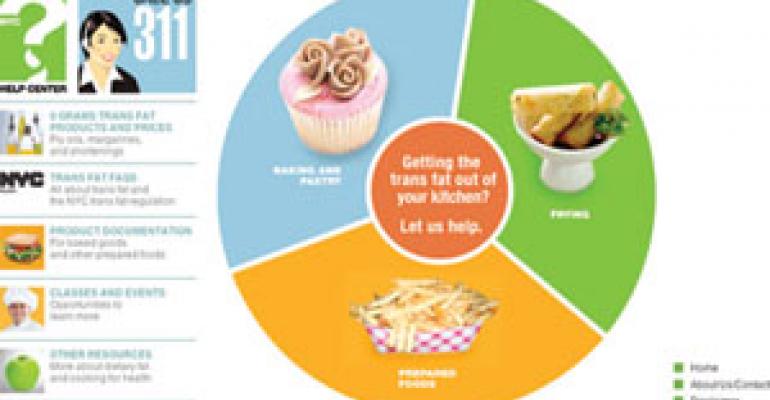The July 1 deadline to eliminate trans fats from all prepared restaurant fare passed without notice at Manhattan’s Blue Water Grill. Executive chef Matt Hughes doesn’t fear getting slapped with a summons—or a $2,000 noncompliance fine, come Oct. 1—because his food is, and always has been, trans-fat-free.
“We don’t use any of those ingredients anyway, so it’s not a problem for us,” says Hughes, who added that the only fats in his kitchen are butter and canola and olive oils. “My personal opinion is this: If it’s a man-made item, then we should try to do without it.”
Undoubtedly, the Big Apple’s trans-fat ban is a watershed moment in America’s battle for better health through food, but it appears the event may cause only a minor stir in the upscale restaurants that were expected to be most affected by the second phase of the ban that went into effect recently. That requirement obliged restaurants to bring the trans-fat content of all their foods, including baked goods, to 0.5 grams or less per serving.
The only exceptions are foods served in their wrappers, such as crackers, which have nutritional information printed on the packaging.
The first phase of the ban, which went into effect last year, required that the transfat content of frying media, including the oil in deep fryers, be lowered to that threshold. Extra time had been granted for baked goods because some trans-fat users said the substitutes available at the time did not deliver the same quality or stability.
But like Hughes, several chefs say their restaurants never have used ingredients containing trans fats. Their baking ingredient of choice is butter. Any ingredients they sourced from outside suppliers that once incorporated trans fats now meet the new regulations, they say.
“This is not going to touch me at all,” says Eric Bedoucha, executive pastry chef and co-owner of Financier Patisserie in Manhattan. “What we do is French pastry, so we don’t use any trans fat, only butter.”
David Waltuck, chef and co-owner of Chanterelle, even chuckles when discussing the ban.
“I haven’t even given it a moment’s thought, actually, because nothing we use would fall under that designation,” he says.
Preparing for the ban hasn’t been so easy for everyone, however. Large-scale food producers have scrambled for the past few years to eliminate trans fats from a staggering variety of prepared foods and ingredients sold to restaurants. Also, restaurant chains that have used trans fats for years had to tweak recipes not only for foods sold in New York, but nationwide.
In its charge to eliminate all trans fat by 2008, Dunkin’ Brands Inc., which operates Dunkin’ Donuts and Baskin-Robbins, auditioned 28 different oils in 80 independent lab tests to find usable alternatives for its doughnuts and ice cream.
“It was a monumental effort by our culinary and R&D teams over nearly four years to achieve that,” says Margie Myers, senior vice president of communications for the Canton, Mass.-based franchisor.
Dunkin’s goals were twofold: ensure customers wouldn’t notice the switch, and make the solution affordable and practical for its 2,300 franchisees.
“We couldn’t be happier with the results,” Myers says, “but it was quite a challenge.”
Boston Market’s highly popular chocolate cake got a favorable reformulation as well, but the chain’s biggest trans-fat-free challenges were the crust lid on its chicken pot pie and its corn-bread side dish.
“We’ve been testing that reformulation in about 70 stores in the New York area for about two months,” says Angela Proctor, senior director of communications with Golden, Colo.-based Boston Market. “In terms of customer feedback … so far so good.”
Proctor says Boston Market’s menu didn’t need a major trans-fat overhaul “because most of it is made up of lean protein and fresh vegetables.” But changing the few items that needed it remained complicated, she says, “because we wanted the flavors to be the same after the change.”
Eager to help restaurateurs go trans-fat-free, New York health officials formed the Trans Fat Help Center, which features a website,
Jeff Zeak, a researcher and pilot plant manager at AIB, says the majority of requests for help have come from food producers rather than restaurateurs.
Producers and their customers, he says, depend on trans fats for shelf stability and affordability, key attributes of the partially hydrogenated oils at the center of the issue.
Zeak complimented fat producers’ efforts to offer alternatives with performance and flavor characteristics similar to those exhibited by partially hydrogenated fats. But he sympathized with food producers and chefs who know replacing those fats with trans-fat-free versions isn’t easy, especially when frying.
“The truth is nothing compares to good old-fashioned hydrogenated soybean oil for frying doughnuts,” Zeak says. “When you make the shift to nonhydrogenated oils, you’ll see flavor differences and differences in the clarity of the oil.”
Zeak says he and his AIB colleagues have heard that cities that considered adopting New York’s trans-fat ban are rethinking that strategy as nutritional details are better understood. Chief among them is the fact that replacing trans fats with other fats, be they natural or manufactured, may solve flavor and performance quandaries without benefiting consumer health.
“When you have a fat that doesn’t contain trans [fat], it’s typically going to be higher in saturated fats,” Zeak says. “So if you switch from trans fat to butter or lard, you’ll get higher cholesterol. You have to pick your poison. If you go any of those ways, you’re going to hit opposing forces.”

